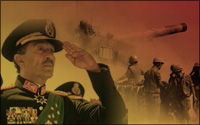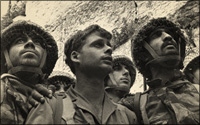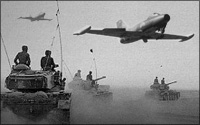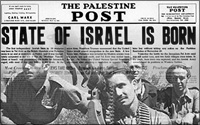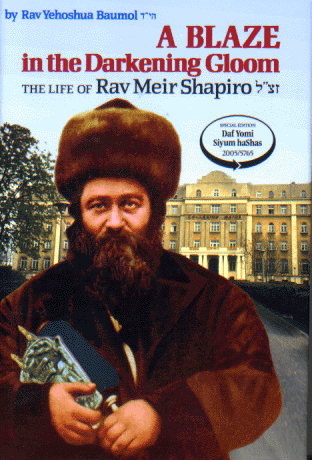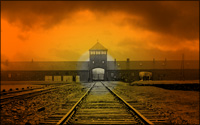 The Holocaust is probably the most difficult topic in modern Jewish history – perhaps in Jewish history. Its scope is beyond human understanding. Merely relating the dry facts cannot do justice to the enormity of it. Certainly it is terribly difficult to make any judgments – judgments regarding people, the world, and how it fits into the pattern of Jewish prophecy and God’s plan. The questions are so enormous as to defy any meaningful answer. Therefore, to a great extent, much of the topic is better left alone.
The Holocaust is probably the most difficult topic in modern Jewish history – perhaps in Jewish history. Its scope is beyond human understanding. Merely relating the dry facts cannot do justice to the enormity of it. Certainly it is terribly difficult to make any judgments – judgments regarding people, the world, and how it fits into the pattern of Jewish prophecy and God’s plan. The questions are so enormous as to defy any meaningful answer. Therefore, to a great extent, much of the topic is better left alone.
However, one cannot avoid its impact on Jewish life since, including the rebirth of the Jewish people in its ancient homeland and the rebirth of Torah within the midst of the Jewish people throughout the world. The Holocaust is not a subject that can be ignored.
A Grisly Monument
Hitler and the Nazis were obsessed by a belief that all the troubles in the world stemmed from the Jews and the solution to the world’s problems lay in their destruction. He set about to accomplish it in a fashion unknown to the history of the world until then, one that remains a grisly monument to the inhumanity and bestial character of man – especially modern man. It is a testament to what happens when man is left alone without any guide of morality or feeling of conscience; without any Higher Authority.
In 1933, when Hitler came to power, he wanted the Jews driven out of Germany, to make it Judenrein (“cleaned” of Jews). He began the process with the boycotting of Jewish stores and businesses. Jews were not given protection of the police. Their shops were looted, their homes destroyed.
He passed laws excluding Jews from public service and escalated the process in 1935 with the Nuremberg racial laws, which removed the Jews from the pale of any civil protection. Finally, he authorized in 1938 the ultimate instrument of terror: Kristallnacht. Jewish homes and synagogues all over the country were destroyed by Nazis mobs – and then the Jews were made to pay for the damage! Arrested Jews were taken away to concentration camps, which was cruel enough. But then, shortly afterward, the closest relative would receive a postcard from the German government saying something to the effect that, “Unfortunately, your husband (or son or father) died (usually of a heart attack), and if you send the German postal authorities three deutsche marks we will mail you the ashes.”
The Germans were able to create a climate where Jews and others were not considered to be human. There was no question of taking human life. That made it possible to kill them like animals in a slaughterhouse – and to do so without pangs of guilt. That psychology was crucial to carrying out the unspeakable crimes the Nazis were committing, and would commit in ever greater numbers and cruelty as time went on. Those who participated in the slaughter lost all cloak of humanity.
Barbarity and Ghettoization
As Germany conquered Europe they subjugated the Jews under their domain in a series of systematic steps that they perfected over time. One of the first things they demanded of the Jews was to wear an identifying mark, often a yellow badge, usually with a Star of David. This strategy succeeded in every country in Europe except one: Denmark. On the day the SS ordered the Jews of Denmark to put on a yellow badge, the king of Denmark put on a yellow badge. Then all the non-Jews of Denmark put on a yellow badge. Of the 7,400 Jews who lived in Denmark, 7,220 escaped. They were transported in fishing boats across the straits into Sweden. The Danes make hollow the excuses of the rest of Europe, who said they could not stand up to the Nazis. If the rest of Europe had behaved with the moral backbone of the Danes the Holocaust as we know it would not have happened.
Nevertheless, the first step was isolating the Jews by making them wear identifying badges. The second step was the concentration of the local Jewish population into ghettos. The most infamous ghettos were Warsaw, Lodz, Bialystok, but there were many others. The ghetto was set up in the slum part of a town with the minimum conditions for survival. The Nazis intentionally constructed it in such a way that it was badly overcrowded. There would not be sufficient shelter, food, sanitation, medical supplies, etc. Jews were subject to starvation, malnutrition, disease exposure to elements in some of the harshest winters in Europe – and random terror.
The ghetto itself was operated by Jews and ran by the Judenrat, which was a Jewish council. These were usually Jewish notables and professionals who were charged with the responsibility of keeping order and enforcing the Nazi decrees. If any member failed to follow Nazis decrees he was killed. Often it was not only the person who disobeyed orders who was killed, but his family. The Germans found it easy to always put someone else on the Judenrat. No one was indispensable.
These people were faced with tremendous moral dilemmas. For instance, in the memoirs of some Judenrat members they took comfort that “only” 2,500 Jews were deported. In their minds, if they hadn’t been there 3,500 would have been taken. In the end, all of them were taken, including those on the Judenrat. But people would do anything to live another day, another hour. It is impossible to judge such people without being in their shoes.
This too was part of the great German cruelty: exploiting the humanity of the victims.
Everything the Germans did was with cruelty. It was one thing to kill – but to kill sadistically is indescribable:
The deportations were coupled with the most cruel tortures to extract money and valuables. Wives were beaten before husbands and children before parents to make them confess where their jewelry was hidden. Rubber truncheons, electric current, flogging of soles and palms, sticking needles under the nails were favorite devices of the Hungarian police, under the general direction of Krumey and Wisliceny.
An 84-year old mother of a distinguish citizen had been taken from the operating table while having her foot amputated for diabetes and thrown straight into the boxcar. This maltreatment so embittered her son that he whipped out a revolver to shoot himself. The weapon was knocked aside but fired anyway and blew off half his face. He also was thrown into the boxcar, unbandaged, after his mother.[1]
Einsatzgruppen Firing Squads
The Germans escalated their campaign of genocide in the summer of 1941, after their initial successes in Russia, with the introduction of the Einsatzgruppen. These were divisions of SS and regular soldiers whose sole purpose was to shoot Jews. They received extra wages, liquor rations and women in the brothels. In spite of that, many members of the Einsatzgruppen committed suicide, went insane or were unable to bear their guilt in some way. That is how gruesome the type of work they did.
An Einsatgruppen would follow the victorious German army into Russia. They would come to a town and with the help of the locals round up the Jews. And there were always plenty of enthusiastic locals, “willing executioners.” They aided the Germans in leading the Jews into the forest, forcing them to dig their own graves and keep decorum as the mass murder was perpetrated.
Many victims were not killed after the first shot. Therefore, as they lay dying in the open pit a German walked on top of the bodies shooting whoever moved. Others not felled by the first bullet simply suffocated to death at the bottom of the pile. Some – very few – escaped. Typically, they waited till night, clawed their way through the corpses and emerged. They may have emerged with their lives but never slept a normal night afterward.
The Nazis were meticulous in their record keeping. According to official German records, the Einsatzgruppen murdered about1.4 million Jews. This included an area outside Kiev known as Babi Yar, where they shot 33,771 Jews in two days on September 29 and 30, 1941. In Kamanetz-Podolsk, 23,600 Jews were executed in three days between August 29 and 31. Outside of Riga in December 1941 the count of dead was 54,696. Notice the exact numbers. These figures were kept by the Einsatzgruppen leaders.
Extermination Camps
These horrors alone were enough to make the slaughter unique in history. But even more incomprehensible is what came next: the extermination camps. They represented the culmination of everything modern man had learned about industrial efficiency. However, now instead of mass-producing cars they mass-produced murder. The world before had never seen anything like it.
In the early days, before the war, the Nazi hierarchy had floated the idea of exporting all the Jews to places like Madagascar. But with the conquest of Europe and the acquisition of millions of Jews those plans quickly evolved into genocide. By the invasion of Poland the apparatus for the mass killing Jews was beginning to take shape. There was no more talk of emigration.
In January 1942, in the picturesque town of Wannsee, high ranking Nazis officials held a secret meeting. Its purpose was to make sure all the branches of government were acting in unison, following the lead of the SS and Gestapo to carry out the “Final Solution.” In order to facilitate their plans they would need to go beyond concentration camps, labor camps and ghettos. They would need extermination camps.
In some of these places, such as Auschwitz, a labor camp existed side-by-side with an extermination camp. As trainloads of Jews arrived from all over Europe, doctors such as the infamous Joseph Mengele would already be standing there to determine who was strong enough for slave labor and who would be directed right away to the gas chambers. Within a couple of hours most of the arrivals to Auschwitz were dead.
The others worked under horrendous conditions. Many of them worked for famous German companies, such as I.G. Farben, Krupp, Daimler-Benz (forerunner of Mercedes Benz) and others. The labor camps would prove almost as deadly – only there the victims died slowly, usually in a matter of months, their bodies withered and wracked with disease due to the backbreaking slave labor from dawn to dusk with minimum rations and no sanitation.
The camp had a hospital, which was not a real hospital but a euphemism for a place where a sick, almost-dead person was left to die or shipped directly to the gas chamber; or worse than that the hospital was a place of medical experimentation. A book on the subject that should be read is The Nazi Doctors by Robert Jay Lifton. It is the most frightening book of its kind because it describes the cruelest types of medical experimentation upon innocent people – experimentation performed by professors and surgeons who took the Hippocratic Oath to save people. Many heads of Germany’s leading clinics participated in these atrocities. Mengele was not an aberration. There was a whole system set up for the German medical industry.
A major logistical problem the Germans had was how to get the Jews to the extermination camps. The solution lay in the complex rail system that ran throughout Europe. They allocated rails and trains exclusively to ship Jews to the death camps – even in the midst of a war, where rails and trains were needed to ship vital supplies and forces to and from the front. Even when it was obvious that the Germans were losing the war they still allocated important transportation assets to the destruction of the remaining Jews instead of the actual war.
Eichmann later said that he would go to his grave happy in the knowledge that he took the lives of millions of Jews. He, like other hardcore Nazis, in effect did not feel they lost the war because they succeeded in destroying European Jewry, and that was their objective. It’s a mentality similar to today’s Islamic suicide bombers. It paid for Europe to be destroyed and go through hell so that they could eliminate six million Jews.
Hungarian Jewry
The last mass deportations took place among Hungarian Jewry. For various reasons, the Jews in Hungary for the first four years of the war lived relatively untouched. However, beginning in March 1944, when it was obvious that the war was going to be lost, the Germans turned their attention to the eradication of all the Jews that they had left under their control.
In May 1944 the deportation of the Hungarian Jews to Auschwitz began in earnest. From May through July 11, 437,402 were sent there. (Again, note the German precision is counting their victims.) It required great organization and effort – all while the Germans were fighting for their lives against the Russians in the east and Americans and British in the west. Again, it puts into perspective the extent of the war against the Jews. That is exactly what it was.
At his trail in Jerusalem, Eichmann prided himself that he ran such an efficient operation, and particularly how he outfoxed the German foreign office. Some high-ranking Nazis who realized they were probably going to be tried after the war were interested in making deals and wanted to let up a little on the Jews. But, as Eichmann testified in detailed memos, he was able to bypass their influence and orders to finish the job and exterminate Europe’s last surviving Jews.
Akiva, Why do you Laugh?
There is virtually no end to the horrors, but this sampling provides at least a partial picture of what happened. It is a picture of the warnings and curses of the Torah. Normally, some people tend to think that the words of the Torah might be given over to hyperbole. The Torah (Deuteronomy 28:34) says that you will become insane from what you will see. If anything, because of the inability of the word to describe reality, the Torah could not convey the horrors that existed in the Holocaust.
The Talmud tells us that the great Rabbi Akiva rejoiced when he saw the jackals that walked on the ruins of the Temple in Jerusalem, while his colleagues wept. When asked why he did not join in their mourning, Rabbi Akiva said that there were two prophecies for the Jewish people: one of utter destructions and another of great redemption and hope. “Now that I see,” Rabbi Akiva said, “that the prophecy of destruction has literally been fulfilled I can rest assured that the prophecy of hope also is not exaggerated.”
The Holocaust, if anything, teaches us that the words of prophecy in the Torah, were literal. The only comfort that we can gain from it is that the prophecies of hope and greatness for the Jewish people also are literal and will burst upon us in a fashion that will allow us to achieve our eventual redemption.


